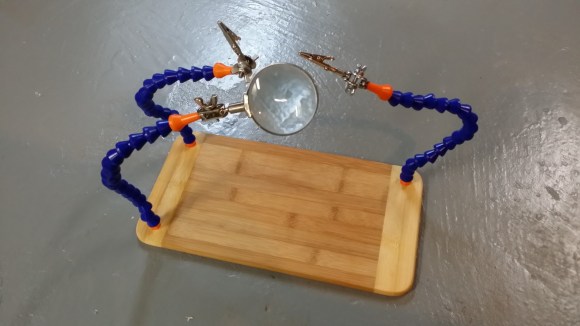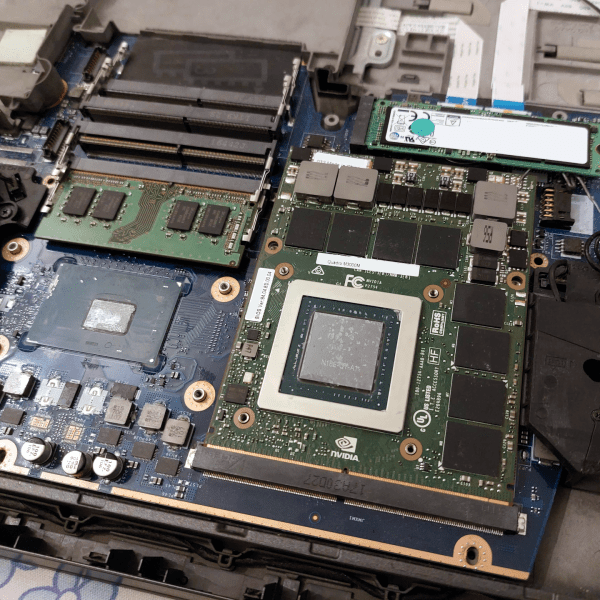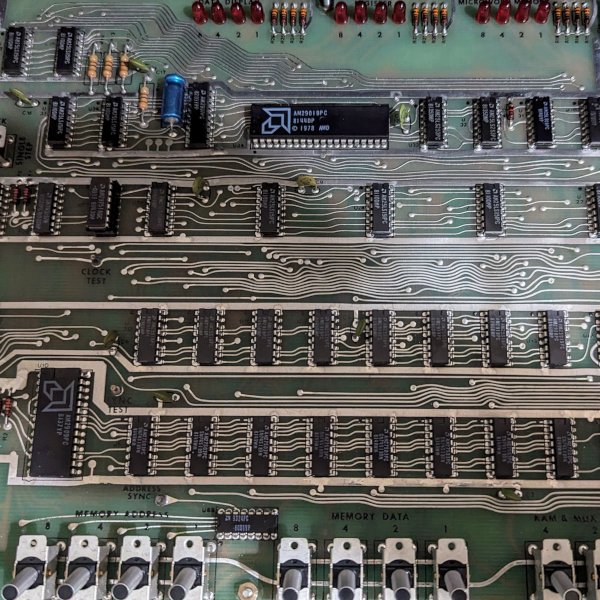
Whether you have shaky hands when working on tiny components, or just need more control and flexibility, we think this “third hand” gripper using coolant hose is an ingenious solution compared to the little metal ones you can buy.
Not surprisingly this isn’t an original idea. In fact, Sparkfun actually sells it as a kit. That being said… it’s rather expensive — especially when you can build [Frank Zhao’s] version for less than $15.
He’s using a cutting board, three machinery style coolant hoses, and a handful of fasteners from the hardware store. You can use the accessories from a regular metal third hand, but [Frank] also shows us how to recreate them using a few washers, some steel strapping, and a wing nut and bolt.
[Mr. Zhao] is no stranger to Hack a Day either — we’d almost call him an inadvertent contributor we’ve shared so many of his hacks! Just take a look at his tiny USB business card, his awesome LED pocket watch, a detailed reflow oven build, or even his IR based augmented reality setup.
[Thanks Keith!]
















Ancient
That’s not even a Haiku.
An alternative to the coolant hose is some regular solid core house wire. That stuff is very stiff but still bendable. Might not be as good as the coolant hose but if you have it laying around it might be the preferred choice.
@StinkySteve
I thought about this but I think repeatedly bending solid core wire would eventually cause it to break
That is exactly what I got on my bench.
5 years of use and it’s not even broken (and at that price repairs are easy)
This project is completly over-engineered in my opinion.
Does anyone know how much torque is required to bend a segement of cooling tube?
This is so bleeding awesome, and to think that I invested in one of those magniifier/clip thingies, and right outside my office the machinists use those gooseneck coolant things every day, and I’m doing a forehead-slap for not thinking of it myself!
Kudos!
Hmm.. for all these years I managed to get everything soldered using rolls of solder wire, coffee cups and other junk on my desk as support or weight :)
While this idea is very cool, I have to agree – I bought one of those helping hand + magnifier things years ago and found that it takes more time to get it into the correct position than actually just balancing the board on various bits of crap and doing the solder joint!
you should get one of those PCB vices, they work really really well in holding the board stable at weird angles. flipping the board over gets real easy too.
Usually, just putting the board flat on the table works fine, otherwise the components fall off.
We had some really sweet board holders at the assembly house I used to work at. I should have stole one. You know, so I’d always have it around to take pictures of to share :) I’ve looked on the net for their like and they’re not very common, the professional ones. The ones we had had speed release positive locking spin mechanisms. They were fast for doing production work. You pushed in on the board a little to unlock it, then you could spin the head around. No amateur Panavise crap. Well, they might have been made by Panavise, I don’t remember today.
This is close to what they looked like but not exactly
http://www.amazon.com/PanaVise-333-Assembly-Circuit-Holder/dp/B000SSR8FY
The problem I have is that I solder quite a bit of connectors, and when I put the connector in, and turn the board over in a device like that, the connector falls out.
So what I usually end up doing is insert the connectors, holding them while I flip the board over and rest it on my desk. Then I solder only one pin of each connector, and check everything is straight, fixing any mistakes before soldering the rest.
@Trui To hold through hole parts onto boards you can bend leads, or use masking tape. Some folks even use Blu-Tack reusable adhesive putty, it says on my package, “Hang up, or hold down almost anything”. Aligning a component with only one lead soldered like you do is a good idea too.
I use surface mount for most components, so that’s not a problem. The through hole components that are left are mostly connectors with short, thick pins, or electrolytics, buzzers, and relays. Only for the electrolytics would bending the leads be an option, but I prefer to trim the leads first, and then mount the component. I think it looks nicer. Masking tape may work, but only for 1 component at a time, and that’s not really saving any time, I think.
Grab a piece of foam, something flat & stiff as a backer and two big clips or rubber bands.
Insert components, put foam and backer on top, hold in place with clips/bands and flip over. Do it on the bench and you just need the foam and a bit of pressure (solder roll).
Obviously works best if the components are the same height.
One helping hand is not too helpful, when I move one clip the other clip ends up moving on me too. Two together is better in my experience. This is how I have mine:
http://i.imgur.com/ahBDRZX.jpg
I manage OK with that setup.
http://www.instructables.com/id/Third-Hand-A-multi-use-helping-hand-for-electro/?ALLSTEPS
So this instructable is not only more interesting but also only four (4) years old.
i have been thinking of making one my self after i saw that, but then again if you don’t feel like making it your self you can always buy a kit from sparkfun
https://www.sparkfun.com/products/11784
No one here mentioned it so I figured I’d throw it out there. Armor jacketed BX electrical cable might make OK articulating goose neck material. I find BX to be a little springy in use myself though.
This is what BX cable looks like in case anyone here doesn’t know what I’m talking about
http://www.seatekco.com/images/bx-02cw.jpg
Camera tripod $3.00
Heatsinks, Alligator Clips – $.50
Broken soldering base – Free
The idea is nothing new or unique.
https://scontent-a-iad.xx.fbcdn.net/hphotos-prn1/t1/76202_606536482712285_568139738_n.jpg
Great hack, love it.
This is pretty much where gorillapod took their idea from.
Those cast iron things haven’t changed in more than half a century. They are too tall and too light. Get a hunk of steel or a gutted transformer core to make a single alligator clip stand. Put rubber on the bottom, it will be very handy. That will be enough for most wire and plug type work as well as small boards.. Make more than one if needed. The rubber and desk will make accurate 2D positioning. It can sit on larger boards for stability.
Like this one? History repeats…
Looks like a blast from the past http://hackaday.com/2008/07/02/another-helping-hand-for-the-work-bench/